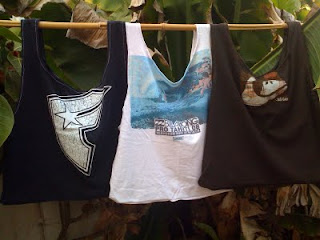
We have been coordinating environmental youth community service projects personally and through our non-profit KIRF using the Roots & Shoots service learning model since our kids were in pre-school. Each project we have done with kids has been a learning experience and has made a difference. I like doing youth service projects with kids and young people because they seem to be more open to change and making a difference.
Since our first youth service project in 2004 (we participated in the fall Coastal Cleanup) our kids have gotten a lot older since then, but the qualities of their favorite projects have not changed.
Each successful project has these qualities:
(1) It is fun
(2) It is social (usually involving something with friends or family members)
(3) It costs almost nothing
(4) It is easy to do
Below are a few fun activities with the above qualities that almost any kid can do to help stop global warming and climate change:
(1) Ride a bicycle at leas

(3) Use reusable non-plastic bags when shopping and in bag lunches. What are plastic b
(4) Make a reusable shopping bag out of an old t-shirts. This is a really fun and creative project using kid’s old t-shirt that they may have outgrown. As a reusable shopping bag. The t-shirt can have a new life as a bag for groceries, soccer clothes, beach stuff, or taekwando clothes. Using reusable shopping bags conserves paper and plastic which are produced using fossil fuels. (Ages 10+) The photo below is of three reusable bags I made out of our son’s old t-shirts. Photo by Angela Rockett Kirwin (me).
Time: 30-45 minutes
Supplies: old t-shirt, thread, sewing machine, scissors, pins.
Directions: Turn the t-shirt inside out. Pin the bottom open end together and sew it. Cut the sleeves, neck seam and hem the arm holes and neck hole. turn in inside-in and voila! You got a reusable shopping bag with handles and maybe cool graphics, too.
(5) Make a reusable gift bag out of an old piece of clothing. I got this idea from the reusable gift bags sold in Patagonia’s retail stores that are made of remnant cloth. Instead of throwing away the fabric scraps Patagonia reused them to make gift bags and added matching ribbon to serve as a tie. (Ages 8+) The photo below is a reusable gift bag used as a swimsuit+goggles bag that was made from one pant leg of old XL men Patagonia boardshort’s. It was made by a nine year old and is modeled by her cat. Photo is courtesy of Jeanne Tanner and was taken by her daughter.
Time: 30-45 minutes per bag
Supplies: thread, sewing machine, pins, scissors, ribbon, old pants, t-shirts, skirts…anything that you can get a large rectangular panel of cloth out of.
Directions: measure out how big a bag you need and then double the width and add 2 inches. (For example, for a small gift bag about 8″x10″ requires a fabric about 10″x 20″.) Fold, pin and then seam the top edge of the bag, wide side, sewing. Fold the fabric in half, inside in, top seams facing in, and sew the bottom part 

Our young children have done all these activities with little assistance from adults, so I know that they are doable and fun.
I believe that our generation and the generations before ours created global warming and it is our generation and the generations after ours that can un-create it. I feel bad that our kids will inherit the mess that we are leaving them. It will take time but we owe it to our kids to teach them to learn from our mistakes that have caused climate change in the first place. Each person, even a five year old, can make a real difference. As environmental activist, humanitarian and primatologist Dr. Jane Goodall once said, “…every individual matters, every individual has a role to play and every individual makes a difference.”
Or in other words, “Be the change you want to see,” said Mahatma Gandhi.
🙂 A
* Read how wild polar bears are in danger of becoming extinct due to global warming: “On Thin Ice” by Daniel Glick, National Wildlife Federation.
** Find out about more age-appropriate community service projects for kids that help animals, the environment and the human community at rootsandshoots.org.
*** Learn about how all plants consume carbon dioxide but trees are best and what you can do at environment.about.com . You can read more about how forests mitigate global warming and a status update on the old growth redwood forests of the Pacific Northwest in the article “The Super Trees” in National Geographic Magazine, October 2009.



